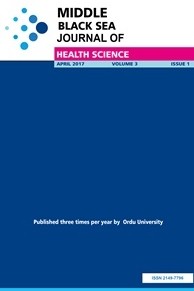Advanced Maternal Age and Adverse Perinatal Outcomes – One Decade Analysis
Objective: To appoint the risk of stillbirth and the other adverse maternal and perinatal outcomes in women of AMA (Advanced maternal age) that traditionally described as pregnancy in women aged 35 years or older. Methods: Our study was a retrospective investigation of all women with singleton pregnancies who gave birth at > 20 weeks’ gestation aged 35 - 39 years old (early advanced maternal aged group, group I, n=926), aged 40 - 49 years old (late advanced maternal aged group, group II, n=184) and aged 20 - 35 years old (control group, group III, n=1110) between January 2008 and January 2018. Parameters such as age, parity, fetal sex, fetal birth weight, birth pattern (cesarean and vaginal delivery) were examined. The variables investigated to determine perinatal outcomes were low birth weight, macrosomic fetus and stillbirth frequency.Results: Advanced maternal aged birth ratio to all births was 4.5 %. 83.4% of the advanced age group were the early advanced maternal aged. The low birth weight rate was significantly higher in the AMA group (8.6 % - 5.9 %) (p=0.042). At the same time, the rate of macrosomia was significantly higher in the AMA group too. (9.5 % - 9.1 %) (p=0.042). The rate of caesarean delivery was significantly higher in AMA group (63.7 % - 56.4 %). The stillbirth rate was significantly higher in AMA group (1,6 % - 0,5 %) (p=0.005). In group II; male gender was lower (47.3 % - 55 %) (p=0.034), stillbirth rate was higher (3.8 % - 1.2 %) (p=0.019), birth weight was lower (3193 - 3287) (p=0.048). Conclusion: The risk of stillbirth was significantly higher in the late advanced maternal aged group. Pregnancies over 35 years of age are high-risk pregnancies necessitating more careful antenatal follow-up in which follow-up of pregnancy must be done more carefully. National mother friendly health policies must focus more on AMA pregnancies. More research is needed to find suitable and well-timed interventions to decrease adverse maternal and also perinatal outcomes.
Keywords:
Advanced maternal age, stilbirth high-risk pregnancies,
___
- Bayrampour H, Heaman M. Advanced maternal age and the risk of cesarean birth: a systematic review. Birth 2010;37:219-26.
- Bianco A, Stone J, Lynch L, Lapinski R, Berkowitz G, Berkowitz RL. Pregnancy outcome at age 40 and older. Obstetrics and Gynecology 1996;87:917-22.
- Cleary-Goldman J, Malone FD, Vidaver J et al. (FASTER Consortium). Impact of maternal age on obstetric outcome. Obstetrics and Gynecology 2005;105:983-90.
- Dulitzki M, Soriano D, Schiff E, Chetrit A, Mashiach S, Seidman DS. Effect of very advanced maternal age on pregnancy outcome and rate of cesarean delivery. Obstetrics and Gynecology 1998;92:935-9.
- Flenady V, Middleton P, Smith GC et al. (Lancet's Stillbirths Series steering committee). Stillbirths: the way forward in high-income countries. Lancet 2011;377:1703-17.
- Fretts RC, Usher RH. Causes of fetal death in women of advanced maternal age. Obstetrics and Gynecology 1997;89:40-5.
- Gilbert WM, Nesbitt TS, Danielsen B. Childbearing beyond age 40: pregnancy outcome in 24,032 cases. Obstetrics and Gynecology 1999;93:9-14.
- Giri A, Srivastav VR, Suwal A, Tuladhar AS. Advanced maternal age and obstetric outcome. Nepal Medical College Journal 2012;15:87-90.
- Godfrey K, Breier B, Cooper C. Constraint of the maternoplacental supply of nutrients: causes and consequence. In: O’Brien S, Wheeler T, Barker D, eds. Fetal Programming Influences on Development and Diseases in Later Life. London, UK: RCOG Press; 1999:283-98.
- Guedes M, Canavarro MC. Characteristics of primiparous women of advanced age and their partners: a homogenous or heterogenous group? Birth 2014;41(1):46-55.
- Haines H, Rubertsson C, Pallant JF, Hildingsson I. Women’s attitudes and beliefs of childbirth and association with birth preference: a comparison of a Swedish and an Australian sample in mid-pregnancy. Midwifery 2011;28:e850-6.
- Ihab M. Usta, Anwar H. Nassar. Advanced Maternal Age. Part I: Obstetric ComplicationsAmerican Journal of Perinatology 2008;25:521-34.
- Kenny LC, Lavender T, McNamee R, O'Neill SM, Mills T, Khashan AS. Advanced maternal age and adverse pregnancy outcome: evidence from a large contemporary cohort. Plos One 2013;8(2)e56583.
- Khalil A, Syngelaki A, Maiz N, Zinevich Y, Nicolaides KH. Maternal age and adverse pregnancy outcome: a cohort study. Ultrasound in Obstetrics & Gynecology 2013;42: 634-43.
- Laopaiboon M, Lumbiganon P, Intarut N, Mori R, Ganchimeg T, Vogel JP, Souza JP, Gulmezoglu AM. Advanced maternal age and pregnancy outcomes: a multicountry assessment. BJOG March 2014; https://doi.org/10.1111/1471-0528.12659.
- Lin HC, Sheen TC, Tang CH, Kao S. Association between maternal age and the likelihood of a cesarean section: A population-based multivariate logistic regression analysis. Acta Obstetricia et Gynecologica Scandinavica 2004;83:1178-83.
- Office for National Statistics (ONS). Births in England and Wales Statistical bulletins 2014.
- O’Leary CM, de KN, Keogh J, et al. Trends in mode of delivery during 1984-2003: Can they be explained by pregnancy and delivery complications? BJOG 2007;114:855-864.
- Roberts CL, Algert CS, Carnegie M, Peat B. Operative delivery during labour: Trends and predictive factors. Paediatr Perinat Epidemiol 2002;16:115-123.
- Royal College of Obstetricians and Gynaecologists (RCOG). Statement on later maternal age. 2011;Compaining and Opinions.
- Salihu HM, Wilson RE, Alio AP, Kirby RS. Advanced maternal age and risk of antepartum and intrapartum stillbirth. Journal of Obstetrics and Gynaecology Research 2008;34:843-50.
- Smith GC, Fretts RC. Stillbirth. Lancet 2007;370:1715-25.
- van Katwijk C, Peeters LL. Clinical aspects of pregnancy after the age of 35 years: a review of the literature. Hum Reproduction 1998;4:185-94.
- Yayın Aralığı: Yılda 4 Sayı
- Başlangıç: 2015
- Yayıncı: Ordu Üniversitesi
